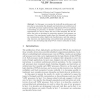Free Online Productivity Tools
i2Speak
i2Symbol
i2OCR
iTex2Img
iWeb2Print
iWeb2Shot
i2Type
iPdf2Split
iPdf2Merge
i2Bopomofo
i2Arabic
i2Style
i2Image
i2PDF
iLatex2Rtf
Sci2ools
HIPEAC
2007
Springer
2007
Springer
Customizing the Datapath and ISA of Soft VLIW Processors
In this paper, we examine the trade-offs in performance and area due to customizing the datapath and instruction set architecture of a soft VLIW processor implemented in a high-density FPGA. In addition to describing our processor, we describe a number of microarchitectural optimizations we used to reduce the area of the datapath. We also describe the tools we developed to customize, generate, and program our processor. Our experimental results show that datapath and instruction set customization achieve high levels of performance, and that using onchip resources and implementing microarchitectural optimizations like selective data forwarding help keep FPGA resource utilization in check.
HIPEAC 2007 | Instruction Set | Microarchitectural Optimizations | Soft Vliw Processor | System Software |
| Added | 16 Aug 2010 |
| Updated | 16 Aug 2010 |
| Type | Conference |
| Year | 2007 |
| Where | HIPEAC |
| Authors | Mazen A. R. Saghir, Mohamad El-Majzoub, Patrick Akl |
Comments (0)

